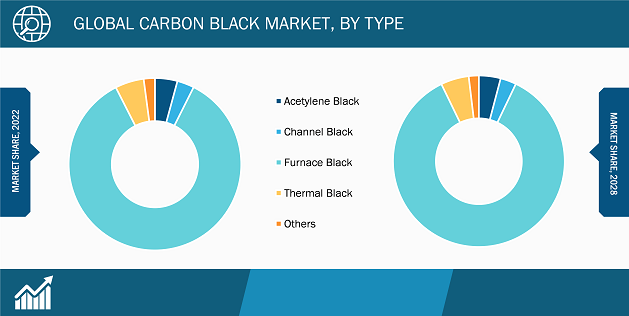Rising Demand from Plastic Industry Supporting Carbon Black Market Growth
According to our latest study on "Carbon Black Market Forecast to 2028 – COVID-19 Impact and Global Analysis – by Type, Grade, and Application," the market is expected to grow from US$ 13,620.57 million in 2022 to US$ 18,514.57 million by 2028; it is estimated to record a CAGR of 5.2% from 2022 to 2028.
Carbon black is a form of elemental carbon manufactured by controlled vapor-phase pyrolysis and partial combustion of hydrocarbons. Various processes have been used to produce carbon black, including the furnace, lampblack, impingement or channel, thermal, and acetylene processes. Carbon black is widely used as a filler in elastomers, plastics, and paints to modify the mechanical, electrical, and optical properties of the materials in which they are dispersed. When compounded with plastics, carbon black imparts unique properties such as UV protection, electrical conductance, opacity, and reinforcement; when used in rubber, these fillers change their fracture behavior and improve abrasion and failure properties. Majority of the worldwide production of carbon black is used by the tire industry, where carbon black enhances tear strength and improves the modulus and wear characteristics of the tires. The rise in passenger vehicles has led to increased demand for automotive tires, driving the carbon black market growth.
Carbon Black Market Breakdown – by Region
Carbon Black Market Size and Forecast (2021 - 2031), Global and Regional Share, Trend, and Growth Opportunity Analysis Report Coverage: By Type (Acetylene Black, Channel Black, Furnace Black, Thermal Black, and Others), Grade (Standard Grade and Specialty Grade), Application (Tire, Non-Tire Rubber, Plastics, Inks & Coatings, and Others), and Geography
Carbon Black Market Growth Report by 2031
Download Free Sample
The rising demand for conductive specialty carbon black products and conductive additives is creating significant potential in various end-use industries such as transportation, industrial, and building & construction. Conductive carbon black is an extremely versatile substance, and it is used for lithium-ion batteries, fuel cells, and polymer applications. Electric vehicles are a promising option to reduce greenhouse gas emissions and air pollution in densely populated areas and contribute to energy diversification.
Manufacturers are increasing their investments in developing countries to meet the surging demand for specialty carbon black. In August 2021, Orion Engineered Carbons SA, a specialty and high-performance carbon black product supplier, started the construction of its second plant in China. The new facility will enable the company to meet the increasing demand for specialty carbon black in the rapidly expanding Asia Pacific market. All these factors are driving the carbon black market.
HiiROC Ltd, Black Bear Carbon BV, Klean Industries Inc., Delta Energy LLC, OMSK Carbon Group Ltd, Imerys SA, Cabot Corp, Tokai Carbon Co Ltd, Orion Engineered Carbons SA, and China Synthetic Rubber Corp are among the key players operating in the carbon black market. These companies have a diverse geographic presence and offer an extensive product range to cater to consumer trends in the carbon black market.
Impact of COVID-19 Pandemic on Carbon Black Market
The COVID-19 pandemic affected economies and industries in various countries across the globe. Lockdowns, travel restrictions, and business shutdowns worldwide hampered the growth of several industries, including the chemicals & materials industry. The shutdown of manufacturing units disrupted global supply chains, manufacturing activities, delivery schedules, and essential and nonessential product sales. Various companies witnessed delays in product deliveries and a slump in sales of their products in 2020. Moreover, the bans imposed by governments of various countries in Europe, Asia Pacific (APAC), and North America on international travel compelled companies to discontinue their collaboration and partnership plans temporarily. All these factors hampered various industries in 2020 and early 2021, thereby restraining the growth of various markets, including the carbon black market. However, in 2021, several economies resumed operation as governments of various countries announced the relaxation of the previously imposed restrictions, which boosted the global marketplace. Further, manufacturers were permitted to operate at full capacity, which helped them overcome the demand and supply gap and other repercussions. As numerous citizens of many countries were fully vaccinated by 2021, the carbon black manufacturers focused on increasing their production to revive their businesses.
The report segments the carbon black market as follows:
Based on type, the carbon black market is segmented into acetylene black, channel black, furnace black, thermal black, and others. Based on grade, the global carbon black market is bifurcated into standard grade and specialty grade. Based on application, the carbon black market is segmented into tire, non-tire rubber, plastics, inks and coatings, and others. By geography, the carbon black market is segmented into North America, Europe, Asia Pacific (APAC), the Middle East & Africa (MEA), and South & Central America.
Contact Us
Phone: +1-646-491-9876
Email Id: sales@theinsightpartners.com